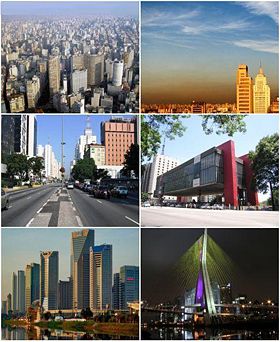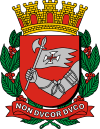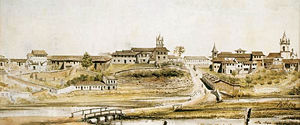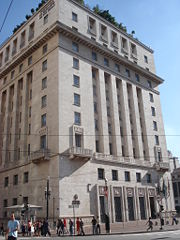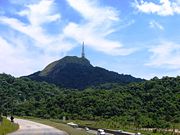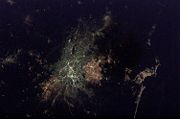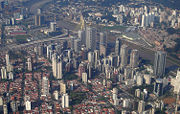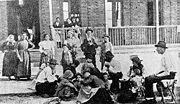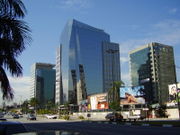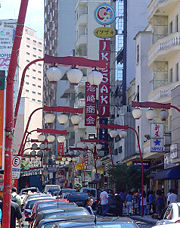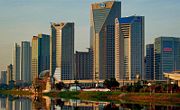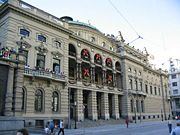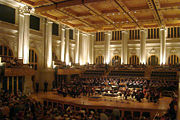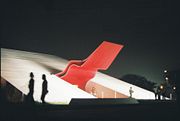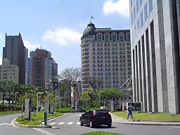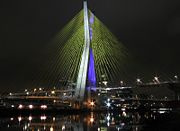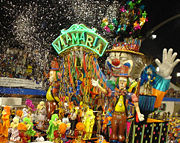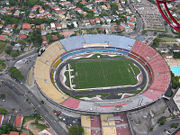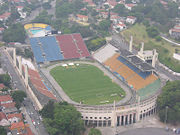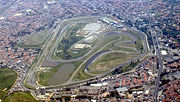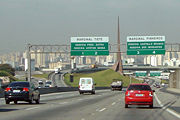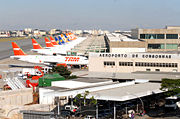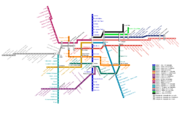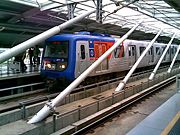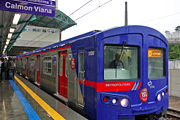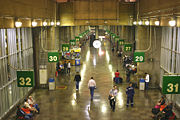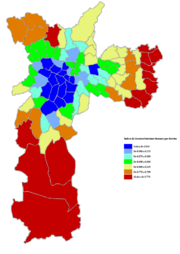São Paulo
2008/9 Schools Wikipedia Selection. Related subjects: Central and South America; Cities
| City of São Paulo | |||
| Clockwise from top left: Aerial view of downtown São Paulo, Edifício Copan at centre; smog over Zona Leste; the São Paulo Museum of Art; the Octavio Frias de Oliveira bridge over the Pinheiros River; high-rise buildings along Marginal Pinheiros; Avenida Paulista, looking towards Rua da Consolação. | |||
|
|||
| Nickname(s): Terra da Garoa (Land of Drizzle) and Sampa | |||
| Motto: "Non ducor, duco" (Latin) "I am not led, I lead" |
|||
| Location of São Paulo | |||
| Coordinates: | |||
|---|---|---|---|
| Country | |||
| Region | Southeast | ||
| State | |||
| Founded | January 1554 | ||
| Government | |||
| - Mayor | Gilberto Kassab ( Democrats) | ||
| Area | |||
| - City | 1,522.989 km² (588 sq mi) | ||
| - Metro | 8,051 km² (3,108.5 sq mi) | ||
| Elevation | 760 m (2,493.4 ft) | ||
| Population (2006) | |||
| - City | 10,886,518 | ||
| - Density | 7,233/km² (18,733.4/sq mi) | ||
| - Metro | 19,977,506 | ||
| - Metro Density | 2,277/km² (5,897.4/sq mi) | ||
| Time zone | UTC-3 ( UTC-3) | ||
| - Summer ( DST) | UTC-2 ( UTC-2) | ||
| HDI (2000) | 0.841 – high | ||
| Website: São Paulo City | |||
São Paulo ( [sɐ̃ʊ̯̃ ˈpaʊ̯lʊ] ) is the capital of the state of São Paulo, Brazil. The city is the largest in Brazil and first in South America by population. It is located in the South East of the country. It is also the richest city of Brazil. The name means Saint Paul in Portuguese.
The city has an area of 1,523 square kilometres (588 sq mi) and a population of 10,886,518, which makes it the most populous in Brazil, in South America and in the southern hemisphere. Greater São Paulo, which includes adjacent municipalities, has a population close to 20 million, making it the second largest in the Americas, and one of the largest metropolitan areas in the world.
People from the city of São Paulo are known as paulistanos, while paulistas designates anyone from the whole of São Paulo state, including the paulistanos. The city's Latin motto is Non ducor, duco, which translates as "I am not led, I lead". A famous nickname for the city is "Sampa". São Paulo is also known for its unreliable weather, the sheer size of its helicopter fleet, architecture and multitude of skyscrapers. The São Paulo/Guarulhos International Airport connects São Paulo with many Brazilian cities and also operates international flights.
History
Jesuit missionaries Manuel da Nóbrega and José de Anchieta founded the village of São Paulo dos Campos de Piratininga on January 25, 1554. Along with their entourage, they established a mission named Colégio de São Paulo de Piratininga aimed at converting the Tupi-Guarani indigenous Brazilians to the Catholic religion. Located just beyond the Serra do Mar cliffs, overlooking the port city of Santos, and close to the Tietê River, the new settlement became the natural entrance from the South East coast to the vast and fertile plateau to the West that would eventually become the State of São Paulo.
São Paulo officially became a city in 1711. In the 19th century, it experienced a flourishing economic prosperity, brought about chiefly through coffee exports, which were shipped abroad from the port of the neighbouring city of Santos. After the abolition of slavery in 1888, and in an effort to "bleach the race," as the Brazilian authorities worried Brazil would turn into a "black country," waves of immigrants from Italy, Portugal, Spain, Germany and many other European countries emigrated to São Paulo in order to, among other reasons, work at the enormous coffee plantations established in the State. At the beginning of the 20th century, the coffee cycle had already plummeted due to, among other factors, a sharp decline in international coffee prices. The local entrepreneurs then started investing in the industrial development of São Paulo, attracting new contingents of overseas immigrants to the city, mainly Italians. In addition to Europeans, Japanese and Syrian and Lebanese immigrants arrived in large numbers in the first half of the 20th century. Along the 20th century, the booming economy of the city also attracted huge waves of migrants from the poorest regions in Brazil, such as the Northeast.
However, due to competition with many other Brazilian cities, which sometimes offer tax advantages for companies to build manufacturing plants in situ, São Paulo's main economic activities have gradually left its industrial profile in favour of the services industry in the late 20th century. The city is home to a large number of local and international banking offices, law firms, multinational companies and consumer services.
Despite its many woes, São Paulo remains the business hub of Latin America. Having prospered first with the coffee industry, and later with industrialisation, in the early 21st century it expanded into the tertiary, or services sector. Its huge market (nearly 20 million people in greater São Paulo) is a magnet for multinationals. Thanks to events such as the Feira Bienal Internacional de Arte, and its reputation for hosting cutting-edge music concerts, it has become something of a cultural centre as well. Economic growth and exportation of goods has lifted employment and wages. The murder rate has dropped by almost a quarter since its peak. The historic centre profited with the return of the city’s government and the arrival of private universities, although businesses continue to move out to new boom districts such as Itaim and Berrini. São Paulo also claims to attract more visitors (mostly, but no longer exclusively, on business) than Rio de Janeiro, testimony of the intense rivalry between the two Brazilian metropolises.
Law and government
In light of its economic and demographic weight, São Paulo has always played a pivotal role in Brazilian politics. With a constituency larger than that of many Brazilian states, the mayor's office is viewed by politicians as a springboard for state and national-level offices.
São Paulo's most recent mayors were:
| Mayor | Entry in | Left Office in | Political Party |
|---|---|---|---|
| Gilberto Kassab | 2006 | - | Democratas |
| José Serra | 2005 | 2006 | PSDB |
| Marta Suplicy | 2001 | 2004 | PT |
| Celso Pitta | 1997 | 2000 | PPB, later PTN |
| Paulo Maluf | 1993 | 1996 | PPB (PP) |
| Luiza Erundina | 1989 | 1992 | PT |
| Jânio Quadros | 1986 | 1988 | PTB |
| Mário Covas | 1983 | 1985 | PMDB |
Geography
Physical setting
São Paulo is located on a plateau that is part of the Serra do Mar (Portuguese for "Sea Range"), itself a component of the vast region known as the Brazilian Highlands, with an average elevation of around 800 metres (2,625 ft) above sea level - though at a distance of only about 70 kilometers (43 mi) from the Atlantic Ocean. This distance is covered by two highways, the Anchieta and the Imigrantes, (see "Transportation" section below) that roll down the range, leading to the portuary city of Santos and the beach resort of Guarujá. Rolling terrain prevails within the urbanized areas of São Paulo but in the North of the city - where the Serra da Cantareira Range boasts higher elevations and a sizable remnant of the Atlantic Rain Forest. The entire region is very stable tectonically, and no significant seismic activity has ever been recorded.
The Tietê River was once a source of fresh water and leisure for São Paulo. However, in the latter half of the 20th century, it became grossly polluted by raw sewage and industrial effluents, much like its tributary the Pinheiros River. However, a substantial clean-up program for both rivers are in the pipeline, financed by international development banks such as the Japan Bank for International Cooperation. Neither river is navigable in the stretch that flows through the city, however water transport becomes increasingly important on the river Tietê further downstream (towards South, near river Paraná), as the river is part of the River Plate basin.
There are no large natural lakes in the region, but the Guarapiranga and Billings reservoirs in the outskirts of São Paulo are used for power generation, water storage, and leisure activities such as sailing.
The original flora consisted mainly of a great variety of broadleaf evergreens. Today, non-native species are common, as the mild climate and abundant rainfall permit a multitude of tropical, subtropical and temperate plants to be cultivated, with eucalyptus being especially ubiquitous.
Climate
| Climate chart for São Paulo | |||||||||||
|---|---|---|---|---|---|---|---|---|---|---|---|
| J | F | M | A | M | J | J | A | S | O | N | D |
|
239
27
18
|
218
28
18
|
160
27
18
|
76
25
16
|
74
23
13
|
56
22
12
|
43
22
12
|
38
23
13
|
81
24
14
|
124
24
15
|
145
26
16
|
201
26
17
|
| temperatures in °C precipitation totals in mm source: Canal do Tempo |
|||||||||||
|
Imperial conversion
|
|||||||||||
According the Köppen climate classification São Paulo has a humid subtropical climate. Temperatures seldom reach 30 °C (86 °F) during summer, while frost is rare during winter due to urban heat island. All-time record temperatures are 35.3 °C (96.6 °F) on November 15, 1985 and -2.1 °C (28 °F) on August 2, 1955 (both at the Mirante de Santana National Weather Station, in the north region). In the mountains around the city (Horto Florestal), -3.9 °C (25 °F) was recorded also in August 2, 1955 (unofficially). Snow flurries were reported officially just on one occasion on June 25, 1918. Rainfall is abundant, especially in the warmer months, but rare between June and August. Neither São Paulo nor the nearby coast has ever been hit by a tropical cyclone, and tornadic activity is uncommon. August is a month which, in the last years, despite of belonging to the winter, is mostly dry and hot, sometimes reaching temperatures of 28 °C (82.4 °F). This is a phenomenon called "veranico" (in Portuguese, "little summer"). On the other hand, January may have some relatively low temperatures in some years.
Metropolitan region
The nonspecific term "Grande São Paulo" ("Greater São Paulo") denotes any of São Paulo's metropolitan area definitions. The legally defined Região Metropolitana São Paulo consists of 39 municipalities in total, and a population of more than 19 million inhabitants (as of 2005, according to IBGE).
Because São Paulo is sprawling like Los Angeles, it has another definition for its metropolitan area. Analogous to the US's CSA ( Combined Statistical Area) type definition of metropolitan area, it is the second largest city in the world with 27 million inhabitants (Complexo Metropolitano Expandido)., which includes 2 contiguous legally defined metropolitan regions, and 3 microregions.
Boroughs
The city of São Paulo is divided into 31 boroughs, called subprefectures (subprefeituras in Portuguese). Each subprefecture is divided into several districts (in most cases, two or three). The subprefectures with the largest number of districts are the boroughs of Sé, in the historical downtown, Butantã, the location of the University of São Paulo, Lapa, Penha and Mooca, all having eleven districts.Together with the administrative division, there is also a geographic radial division established in 2007 by the mayor Gilberto Kassab. The city is divided in ten regions (historical downtown, extended downtown, north, south, east, west, northeast, northwest, southeast and southwest), each one identified with a distinct colour in the buses and in the street plaques. These divisions have no relationship with the subprefectures and districts, and, in some cases, the same district may be in two or more geographic regions. The district where the headquarters of the subprefecture is located receives the same name of the subprefecture, with exception of M'Boi Mirim.
Demography
- Changing demographics of the city of São Paulo

Demographics
São Paulo is the most ethnically diverse city in Brazil. After the end of the African slave traffic in the country (1850), São Paulo started to replace the African manpower with immigrants in the coffee plantations. The pioneer in this new project was the senator Nicolau Vergueiro, who brought German, Swiss and Portuguese people to work in his own properties.
After the abolition of slavery (1888), São Paulo received large numbers of immigrants, most of them coming from Italy. In 1897, Italians were over half of the city's population. Portuguese, Spaniards, Germans, Jews and Christian Lebanese and Syrians also came in significant numbers. From 1908 to 1950, many Japanese immigrants arrived.In the 1960s, Chinese and Koreans started arriving. In the mid-20th century, many people from the poor Northeast Brazil started to migrate to São Paulo. Nowadays, there is a growing Bolivian community in the city.
As in all of Brazil, people of different ethnicities mix with each other, producing a multi-ethnic society. Today, people of 100 different ethnicities make São Paulo their home. The main communities are:
- 6 million Italians (including descendants).
- 3 million Portuguese (including descendants).
- 3 million Africans (including descendants).
- 1 million Arabs (including descendants).
- 400,000 Germans (including descendants).
- 326,000 Japanese (including descendants).
- 120,000 Chinese (including descendants).
- 70,000 Jews (including descendants)..
- 60,000 Bolivians.
- 50,000 Greeks (including descendants).
- 50,000 Koreans (including descendants).
Ethnically, São Paulo is made up of 8 million Whites, 2,6 million mixed-race ( Pardos), 527 thousand Blacks, 456 thousand Asians and 18 thousand Amerindians.
Religion
| Religion | Percentage | Number |
|---|---|---|
| Catholic | 68.11% | 7,107,261 |
| Protestant | 15.94% | 1,663,131 |
| No religion | 8.97% | 936,474 |
| Kardecist | 2.75% | 286,600 |
| Buddhist | 0.65% | 67,591 |
| Jewish | 0.36% | 37,500 |
Source: IBGE 2000.
Languages
As in all Brazil, the language spoken by the vast majority of the population is Portuguese. Due to the large influx of Italian immigrants, the Portuguese spoken in the city reflects a significant influence from the dialects of the Italian language. The Italian dialects mixed with the countryside Caipira accent of São Paulo; some linguists maintain that the São Paulo dialect of Portuguese was born in Mooca, a district settled in the early 20th century mainly by people from Naples, southern Italy.
Other languages spoken in the city are mainly among the Asian community: Liberdade district is home to the largest Japanese population outside of Japan. Although today most Japanese Brazilians can speak only Portuguese, some of them are still fluent in Japanese. Some people of Chinese and Korean descent are still able to speak their ancestral languages. However, most of the Brazilian-born generations only speak Portuguese.
English and Spanish are taught as foreign language in most schools, although only a small percentage of residents exhibit a high degree of fluency in either language.
Statistics
- Vehicles: 6,000,000 (March 2007)
- Daily newspapers: 19 (May 2007)
- Foundation date: 01/25/1554
Economy
São Paulo is the 19th richest city of the world and is expected to be the 13th richest in 2020. According to data of IBGE, its Gross domestic product (GDP) in 2005 was R$ 263,177,148,000.00 (US$ 156,280,780,941.00), equivalent to approximately 12.26% of the Brazilian GDP and 36% of all production of goods and services of the State of São Paulo.
One of the biggest financial centres of Brazil and the world, São Paulo's economy is going through a deep transformation. Once a city with a strong industrial character, São Paulo's economy has become increasingly based on the tertiary sector, focusing on services and businesses for the country.
Many analysts point to São Paulo as an important global city, even though this assignment can be criticized considering its serious problems of social exclusion and spacial segregation. Although being the most important financial centre of the country, São Paulo's economy also presents a high degree of informality.
The São Paulo Stock Exchange (BM&F Bovespa) is Brazil's official stock and bonds exchange. The BM&F Bovespa is the largest stock exchange in Latin America and third largest in the world.
The per capita income for the city was R$ 24,083 (2005).
Culture
Music
Adoniran Barbosa was a famous samba singer and composer who became successful during São Paulo's radio era. Born in 1912 in the town of Valinhos, Barbosa was known as the composer to the lower classes of São Paulo, particularly the poor Italian immigrants living in the quarters of Bexiga (Bela Vista) and Brás, as well as the poor who lived in the city's many shanties and cortiços (degraded multifamily row houses). The topics of his songs are drawn from the life of low-wage urban workers, the unemployed and the vagabonds. His first big hit was Saudosa Maloca ("Shanty of Fond Memories", 1951), wherein three homeless friends recall with nostalgia their improvised shanty, which was torn down by the landowner to make room for a building. In his Trem das Onze ("The 11 PM Train", 1964) record, which has been ranked one of the five best samba songs ever, the protagonist explains to his lover that he cannot stay any longer because he has to catch the last train to the Jaçanã suburb, for his mother will not sleep before he arrives. An old-school samba band called Demônios da Garoa still plays his songs in the traditional Bar Brahma venue in the Centro.
In the late 1960s, a psychedelic rock band called Os Mutantes led the way in the national avant garde music scene. Their success is sometimes related to that of other tropicalia musicians, but they also had a musical style and ideas of their own. They were regarded as very paulistanos in their behaviour and clothing. Os Mutantes released five albums together before lead singer Rita Lee departed in 1972 to start a solo career. Although almost exclusively known in Brazil at that time, Os Mutantes became quite successful abroad after the 1990s (a well-spread legend has it that one Brazilian girl in an exchange programme in California, U.S., forgot one Mutantes' vinyl record in her American host family, leading the way to the popularisation of the band in that U.S. state). In 2000, a record sung in English, Tecnicolor, was released with artwork designed by Sean Lennon.
After the two oil price shocks in the 1970s, the country suffered from an economic recession during the 1980s, a phenomenon that was named the lost decade. The very repressive military government of the day did not help in any way the social situation. A late punk and garage scene became strong in the 1980s, perhaps associated with the gloomy scenario of unemployment and few actual prospectives from the viewpoint of the youth. Underground rock bars and clubs in town were full of thriving musicians and artists waiting for their moment to come. Examples of bands originating from this movement include Ira! and Titãs. In the 1990s, drum & bass became another musical movement in São Paulo, with artists such as DJ Marky, DJ Patife, XRS, Drumagick, and Fernanda Porto. Many heavy metal bands also originated in São Paulo, such as Angra, Torture Squad, Korzus and Dr. Sin. Many "alternative" cultures of São Paulo mingle at a small shopping mall dubbed Galeria do Rock (English: "Rock Gallery"), which includes shops which cater to a broad range of alternative niches. Famous alternative band Cansei de Ser Sexy, or CSS (Portuguese for "tired of being sexy") also came from São Paulo.
The classical music in São Paulo is also very prevalent. Many of the most important classical Brazilian composers who are still alive, like Amaral Vieira, Osvaldo Lacerda and Edson Zampronha, were born in and live in São Paulo. São Paulo has two important opera houses: Teatro Municipal de São Paulo and Theatro São Pedro, and some opera performances are sometimes hosted in other theaters like Credicard Hall. Local baritone Paulo Szot has won international acclaim and a Tony Award nomination for his performance in a 2008 revival of South Pacific. The São Paulo State Symphony is one of the outstanding orchestras in Latin America and in the world.
Literature
São Paulo was home to the first jesuit missionaries in Brazil, in the early 16th century. They wrote reports to the Portuguese crown about the newly found land, the native peoples and composed pieces of poetry and music for the catechism. Among them were priests such as Manuel da Nóbrega and José de Anchieta, living in or near the colony then called Piratininga. They also helped to register the Old Tupi language, lexicon and its grammar.
The Brazilian Modernist Movement as an organized trend started in São Paulo in 1922. Both these authors were influential writers form the Modernism in Brazil:
- Mário de Andrade
- Oswald de Andrade
Sites of interest
São Paulo is a major cultural centre. The city has an ethnically diverse metropolitan area, with heavy Italian, Portuguese, Spanish, Arabic, Japanese, among other influences.
The city is known for its varied and sophisticated cuisine, ranging from Chinese to French, from fast food chains to five star restaurants. There are approximately 62 different types of cuisines in São Paulo, and more than 12,000 restaurants. Other venues such as bars, pubs, lounges and discos cater to a variety of music tastes.
São Paulo is home to the São Paulo Museum of Art (MASP), dedicated by Queen Elizabeth II in the first half of the XX century and "Pinacoteca do Estado" art museums, a symphonic orchestra ( São Paulo State Symphony (OSESP - based in the Sala São Paulo theatre in the gorgeous Julio Prestes train station), and a Formula One Grand Prix racing circuit ( Interlagos).
Landmarks
- Avenida Paulista (one of the most important thoroughfares of the city and the site of many cultural centers and museums, such as the MASP and Centro Cultural Itaú)
- Banespa Building (skyscraper with observation deck and museum designed after the Empire State building)
- Catedral da Sé (the metropolitan cathedral, a symbol of the city)
- Edifício Copan, designed by Oscar Niemeyer, in the Centro neighbourhood. Built between 1951 and 1966, its wavy shape gives the building an impression of movement, and the integration of small businesses and residential flats are of innovative urbanism.
- Edifício Itália (skyscraper with observation deck)
- Estação da Luz (historical railway station built 1895-1901)
- Ibirapuera Park (the second largest park of the city (Parque do Carmo is the biggest), is also home to several museums. It is known for its buildings designed by Brazilian architect Oscar Niemeyer, such as the Oca and the new Ibirapuera Auditorium)
- Liberdade (Asian district of São Paulo).
- Memorial da América Latina (another complex of buildings designed by Oscar Niemeyer)
- Mercado Municipal (historical market place in São Paulo)
- Municipal Theatre of São Paulo (magnificent opera house built in the early 20th century
- Museu de Arte Sacra (museum of religious art located in a colonial convent)
- Museu do Ipiranga (museum built where the Independence of Brazil was proclaimed in 1822)
- Museum of the Portuguese Language (located inside Estação da Luz)
- Pátio do Colégio (founding site of the city, former Jesuit mission-school to convert the natives to Catholicism)
- Pinacoteca do Estado de São Paulo (important museum of Brazilian art)
- Praça da Sé (large square next to the São Paulo Cathedral. Official centre of the city)
- Shoppings Malls Iguatemi, Ibirapuera, Morumbi, Eldorado
- Solar da Marquesa (rare example of 18th century architecture)
São Paulo has 280 movie theatres, 120 theatres, 71 museums, 39 cultural centers and about 70 shopping malls.
Events
There are some Web sites and magazines specialising in the cultural events in the city, including the Agenda Cultural de São Paulo (São Paulo's Cultural Calendar).
Bienal de São Paulo
The São Paulo Art Biennial is a cultural event hosted in town every two years. Almost 1 million people visited the 26th Bienal in 2004. Its theme was chosen to enable a wide range of artistic positions to feel comfortable. The concept of "Free Territory" involved various dimensions: it had a physical-geographical, a socio-political as well as an aesthetic dimension — the latter, of course, being of greatest interest in the context of this exhibition.
In order to emphasise the thematic unity of the overall exhibition, the invited artists and those representing the countries are mixed together on the 25,000 square metres of the spacious Oscar Niemeyer Pavilion. Despite the complexity of individual voices, the final result was intended to be a unity.
In addition to an intensification of the North-South dialogue inside Brazil, the Bienal's aims include the promoting of links between non-European cultures along a South-South orientation. The next edition of the Biennale will take place in 2008.
São Paulo Fashion Week
Brazil first entered the international fashion circuit with the increasing reputation of famous Brazilian top models such as Adriana Lima, Gisele Bündchen, Alessandra Ambrosio, Fernanda Tavares, Ana Beatriz Barros, Izabel Goulart and Ana Hickmann, and the "discovery" of some fresh talents such as Alexandre Herchcovitch by some international fashion magazines. As a consequence of this, São Paulo Fashion Week is the place to see and to be seen in Brazilian fashion scene, always attracting a number of international editors and models.
Electronic Language International Festival
The Electronic Language International Festival is a non-profit cultural organization, whose purpose is to disseminate and to develop arts, technologies and scientific research, by means of exhibitions, debates, lectures, and courses. The festival promotes a yearly meeting in Brazil, in the city of São Paulo. The event is open to the public, and intends to expand its educational reach to local and eventually remote audiences, thus sharing the experiences learned with FILE, through technologies of education, communication, registration and memory. The File Festival show in its events web art, net.art, artificial life, hypertext, computer animation, real time teleconferences, virtual reality, panoramas, interactive movie, e- video, electronic art installations and robotics through interactive and immersive rooms.
Festival of Electronic Art
Every two years, Associação Cultural Videobrasil's International Electronic Art Festival brings groundbreaking work by cream-of-the-crop artists from all over the world to São Paulo. In keeping with the constant transformations in media and support, the curatorship has added installations, performances, VJs, CD-ROM art, and Internet art to the programme.
The Festival includes a competitive exhibition of so-called southern circuit and an extensive parallel programme. Art shows, debates and meetings introduce new ideas and artwork, setting new guidelines for contemporary art in Brazil.
Exhibitions featuring work by prominent electronic artists are also part of the Festival. Brazilian pioneers such as Rafael França and Olhar Eletrônico, and international guests such as Nam June Paik, Bill Viola and Gary Hill, have featured in the event’s past editions. Each edition has a theme of its own.
- January 25 São Paulo anniversary municipal holiday
- São Paulo Fashion Week
- Anima Mundi — an international competitive video and film festival devoted exclusively to animation)
- AnimeCon — International Anime Convention
- AnimeDreams — International Anime Convention
- Anime Friends — International Anime Convention
- Mercado Mundo Mix
- São Paulo International Film Festival
- São Paulo International Short Film Festival
- Carnival of São Paulo
- Virada Cultural, 24 hr Music & Arts shows throughout the city in April
- Skol Beats
- Tim Festival — indie music festival
- Nokia Trends
- Corpus Christi Mass in solemn procession on decorated streets, mostly in State towns: May or June
- Gay Pride Parade - May: Avenida Paulista
- Festas Juninas celebrating 3 popular saints Anthony, John, & Peter: June 13,24,29 or their eve - square dance
- 9 de Julho --July 9th--Constitutional Revolution - holiday in São Paulo
- Festa de N. S. Achiropita in Bixiga in August
- San Gennaro Feast in Bras in August
- 7 de Setembro --Sept 7th-- Independence Day Parade
- 12 de Outubro --Oct 12th-- Children's Day & Lady Aparecida, patroness saint of Brazil
- November 2 - All Souls' Day holiday with cemetery visits, candle lighting & Mass
- November 15 Proclamation of the Republic/Election Day
- December 8 Immaculate Conception/Yemanja' Day with African Brazilian offerings to the goddess of the sea in Santos
- Christmas/New Year season: concerts at municipal theatre, Sala Cidade de São Paulo, Se' Cathedral & Protestant churches, & shoppings malls. Decorations & carols along avenida Paulista.
- December 31 Sao Silvestre international race & concerts/fireworks on avenida Paulista
- Fenasoft (International Computer and Software Trade Fair)
- UD Fare — Domestic Utilities Fair
- Feira Bienal Internacional de Arte de São Paulo - Ibirapuera Park
- Feira Internacional do Livro — Book International Fair
- São Paulo Restaurant Week
Sports
Football
As in the rest of Brazil, football is by far the most popular sport in the city. The major teams in São Paulo are Corinthians, São Paulo and Palmeiras (in this order, the second, third and fourth most popular teams in Brazil ). There are three other small clubs in the city, Portuguesa, Juventus and Nacional. Another popular club in São Paulo is Santos FC from the nearby coastal city of the same name, Santos.
São Paulo is one of the 18 remaining candidates to host games of the 2014 FIFA World Cup, for which Brazil is the host nation.
Football/Soccer teams
| Club | League | Venue | Established | Capacity |
|---|---|---|---|---|
| São Paulo FC | Série A (1st Division) | Morumbi Stadium | 1930 | 80,000 (138,032 record) |
| Palmeiras | Série A (1st Division) | Palestra Itália Stadium | 1914 | 29,173 (40,283 record) |
| Portuguesa | Série A (1st Division) | Canindé Stadium | 1920 | 19,717 (25,000 record) |
| Corinthians | Série B (Relegated to the 2nd division in 2007) | Parque São Jorge Stadium | 1910 | 18,386 (27,384 record) |
| Juventus | Something like the 4th division (just play the Paulista State Championship) | Rua Javari Stadium | 1924 | 2,730 (9,000 record) |
| Nacional | Something like the 5th or 6th division (regional league) | Nicolau Alayon Stadium | 1919 | N/A |
Corrida de São Silvestre
The São Silvestre Race takes place every New Year's Eve ( 31 December). It was first held in 1925, when the competitors ran about 8,000 metres across the streets. Since then, the distance raced has varied, and it is now fixed at 15 km. Registration takes place from 1 October, with the maximum number of entrants limited to 15,000.
Brazilian Grand Prix
The Brazilian Grand Prix (Portuguese: Grande Prêmio do Brasil) is a Formula One championship race which occurs at the Autódromo José Carlos Pace in Interlagos. In 2006 the Grand Prix was the final round of the FIA Formula 1 World Championship. The Spanish driver Fernando Alonso won the 2006 drivers championship at this circuit by coming second in the race. The race was won by the young Brazilian driver Felipe Massa, driving for the Scuderia Ferrari team.
Other sports
Volleyball, basketball and tennis are other major sports. There are several traditional sports clubs in São Paulo that are home for teams in many championships. The most important are Esporte Clube Pinheiros (waterpolo, volleyball, swimming, basketball and handball), Clube Atlhetico Paulistano (basketball), Esporte Clube Banespa (volleyball, handball and futsal), Associação Atlética Hebraica (basketball) and São Paulo Athletic Club (rugby union).
International sports events
The following international sports events have been held in São Paulo:
- 1950 — FIFA World Cup (football)
- 1963 — Pan American Games (Multi-sports)
- 1971 — FIBA World Championship for Women
- 1977 — Women's U20 Volleyball World Championship
- 1983 — FIBA World Championship for Women
- 1993 — Volleyball World League
- 1994 — Women's Volleyball World Championship
- 2000 — FIFA Club World Championship (Football)
- 2005 — World Cup in Artistic Gymnastics
- 2006 — International Police and Fire Games (Multi-sports)
- 2006 — FIBA World Championship for Women (Basketball)
- 2006 — 13th World Cup Final in Artistic Gymnastics
- 2007 — 3rd International Blind Sports Association World Championships and Games
Transportation
See: Transport in São Paulo
Motorways
The city is crossed by many of the most important Brazilian motorways, such as the BR-116, Rodovia Raposo Tavares, Rodovia Anhangüera, Rodovia dos Bandeirantes, Rodovia Anchieta, Rodovia Castelo Branco and Rodovia dos Imigrantes. Automobiles are still the main means to get into the city.
Rodoanel
São Paulo grew quickly from the 1940s to the 1980s and many roads and buildings were built without major planning. As a result, heavy traffic is common on the city's main avenues, and traffic jams are relatively common on its largest highways. The main means of commuting into the city is by car and by bus. An effective way of avoiding heavy vehicles traffic in the city, such as buses and trucks that crossed the city for other destinations, was planned by ex-governor Mário Covas as a road ring that circles the city, called Rodoanel Mario Covas, and is being built by DERSA.
Railways
Although poorly served by heavy rail services, there is an infrastructure project to build a high-speed railway service linking Brazil's two largest cities, São Paulo and Rio de Janeiro. The trains would go as fast as 280 km per hour (the trip would last about 1 hour and 30 minutes). This specific project is still waiting an official announcement by the Brazilian government, who is trying to obtain international financing through a public-private partnership.
Another important project is the "Expresso Bandeirantes", which is a medium-speed rail service (about 160 km/h) from São Paulo to Campinas, which would reduce the journey time from the current one hour and a half by car to about 50 minutes by train, linking the towns of São Paulo, Jundiaí, Campinas Airport, and Campinas city center. This service is also going to be connected to the railway service between São Paulo city centre and Guarulhos Airport.
Major works on an express railway service between São Paulo city centre and Guarulhos International Airport were announced by the São Paulo state government in 2007, which will be a milestone in the revitalisation and improvement of the Brazilian passenger railway services.
Airports
São Paulo has three airports. There are two major airports in the São Paulo metropolitan area: São Paulo/Guarulhos International Airport ( IATA: GRU) for domestic and international flights and Congonhas ( IATA: CGH) for domestic flights. There's also a small airport known as Campo de Marte north of the Old Centre for small, private aircraft and helicopters. Campo de Marte also hosts the Ventura Goodyear Blimp.
Congonhas Airport operates domestic and regional flights, mainly to Rio de Janeiro, Belo Horizonte and Brasília. Campo de Marte airport handles some private and small-sized airplanes. Guarulhos International Airport, also known to São Paulo dwellers as "Cumbica", is located 25 km North East of the city centre, in the neighbouring city of Guarulhos. Guarulhos airport operates both domestic and international flights.
On 2007- 07-17 the worst airline accident in Brazil's history occurred at Congonhas airport, blamed on rain and a shortended runway. 199 people from the plane and on the ground died. Following the accident, pilots refused to land under rainy conditions and the Brazilian President signed an act so that ticket sales for flights to the airport be stopped. Aviation throughout the entire country reached a crisis state, which is slowly being overcome by new safety measures such as the introduction of a grooved pavement in the runways.
In 2006, about 34,3 million people went through the city's airports (mainly from Congonhas and Guarulhos International Airport, the only two operating commercial flights). Infraero, Brazil's main aviation authority, estimates that with the remodelling of Guarulhos Airport, São Paulo's airports will be able to handle about 45 million passengers a year within the next five years. There are also plans to expand the Viracopos-Campinas International Airport at Campinas, a city about 90 km North of São Paulo.
São Paulo has allegedly one of the highest per capita helicopter ownership in the world. The owners are an elite wealthy class who take advantage of around one hundred helipads and heliports to conveniently avoid heavy traffic.
Underground and light rail system
The city has 61,3 km of underground railway systems (34.6 km fully underground) (the São Paulo Metro, locally known as the Metrô), with 4 lines in operation and 55 stations, complemented by another 261,7 km of Companhia Paulista de Trens Metropolitanos (CPTM, or "Paulista Company of Metropolitan Trains") railways. Both CPTM and the underground railway lines carry some 5 million people on an average weekday, and a few new underground lines to be constructed are expected to add another million people to the system within the next five years. The projects expected to expand São Paulo's urban railway system from the current 323 km to more than 500 km on the next 10 years.
São Paulo has three rapid transport systems:
- The underground rail system (called "metrô", short for "metropolitano"), with three complete lines
- The suburban rail system, Companhia Paulista de Trens Metropolitanos (CPTM), has six lines that serve many regions not reached by the underground system, and even some other cities in the metropolitan region. The CPTM network is longer than the underground rail system.
- The fast-lane bus system: there are many such bus lines in the city, called "Passa Rápido", which are street-level, placed on large avenues, and connected with the underground or suburban train stations.
São Paulo has no tram lines, although trams used to be common in the first half of the 20th century.
São Paulo's underground train system is modern, safe, clean and efficient, considered one of the best subway systems in the world, as certified by the NBR ISO 9001. It has four lines (a fifth, the Yellow line, is under construction) and links to the metropolitan train network, the CPTM.
The underground rail lines are:
- Line 1 - Blue: The first Metrô line built connects the North and the South Side of São Paulo. Connections are available for the Green, Red and Yellow lines and also for CPTM trains. Tietê and Jabaquara bus terminals are also reachable through the use of this line.
- Line 2 - Green: The Green line transverses the Avenida Paulista ridge, connecting Ipiranga to Vila Madalena, and also integrating the Blue and Yellow lines. It was the third Metrô line built.
- Line 3 - Red: One of São Paulo's busiest lines, the second Metrô line built connects the East Side to the West Side. Connections to the Blue and Yellow lines are possible, as are with CPTM trains. The Barra Funda bus terminal is located on this line.
- Line 4 - Yellow (under construction): Scheduled to be open in 2009, the Yellow line will connect the central Luz station to the west side in a route constructed immediately below the Consolação and Rebouças avenues. Connections will be available to the Blue, Green and Red lines and to CPTM trains.
- Line 5 - Lilac: Built for users who need to reach specific places in São Paulo's South Side. Only a short distance of the line is already available (six complete stations), connecting to CPTM trains at Santo Amaro station.
- Line 6 - Orange (planned): Announced in 2008 and scheduled to be open in 2012, the Orange Line will connect the borough of Freguesia do Ó, in the northwestern side of the city to downtown São Paulo. It will be connected to the subway lines 1 and 4, as well as the line 7 of CPTM.
The following lines are composed by surface trains and managed by CPTM, named after precious stones:
- Line 7 - Ruby: Formerly the northern part of the ancient São Paulo Railway, it connects the Luz station downtown to the city of Francisco Morato, crossing all of the northwestern side of the city. An operational extension connects Francisco Morato to the city of Jundiaí. This is the longest line of the railway system in São Paulo.
- Line 8 - Diamond: Formerly part of the ancient Estrada de Ferro Sorocabana, it connects the Julio Prestes station downtown to Itapevi, going across the western side of the city. An operational extension with another train links this line to four more stations in Itapevi. The last station (Amador Bueno) is placed near the border with São Roque. The Julio Prestes station houses the State of the Art concert hall Sala Cidade de São Paulo.
- Line 9 - Emerald: It's located along the Nações Unidas Avenue (Marginal Pinheiros), and connects the region of the Interlagos Speedway to the neighbouring city of Osasco. Presently, it makes the only connection with the subway Line 5 - Lilac.
- Line 10 - Turquoise: Formerly the southern part of the ancient São Paulo Railway, it's actually a continuation of the Line 7 - Ruby, and crosses the ABC Region.
- Line 11 - Coral: Also known as "Expresso Leste" (East Express), it crosses all the eastern side of São Paulo from downtown, to Guaianases. It is within the largest distance between two stations (between Tatuapé and Itaquera) in all the railway net. There is an operational extension from Guaianases to the campus of the Universidade de Mogi das Cruzes, in the city of Mogi das Cruzes.
- Line 12 - Sapphire: It crosses the northeastern side of São Paulo, from the Brás station downtown until the city of Itaquaquecetuba.
Buses
The bulk of the public transport (government and private companies) is composed of approximately 17,000 buses (including about 210 trolley buses), coloured uniformily according to the non-central region served (ex.: light green for the buses that go South West, dark blue for the Northern area). Until the past few years, there was a strong presence of informal transport vans (dab vans), but the vast majority of such vans are already fully registered with the city council, legalized and operating under the same colour scheme of the main system.
Helicopters
Specially because of the intense traffic jam, São Paulo has become the city with the highest number of helicopters in the world, more than cities like New York and Tokyo. With more than 400 helicopters and around 7000 flights per year São Paulo, according to the British newspaper The Guardian, is turning into a "real life South-american episode" of The Jetsons.
Current critical problems
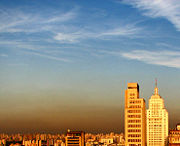
Since the beginning of the 20th century, São Paulo has been a major economic centre in Latin America. With the arrival of the two World Wars and the Great Depression, coffee exports to the United States and Europe were critically affected, leading wealthy coffee farmers to invest in industrial activities which eventually turned São Paulo into Brazil's largest industrial hub. The new job positions thereof contributed to attracting a significant number of immigrants from Europe and Asia and migrants from within the country, especially the northeastern states. From a population of merely 32,000 inhabitants in 1880, São Paulo increased its population to approximately 250,000 in 1900, 1,800,000 in 1940, 4,750,000 in 1960 and 8,500,000 in 1980. The effects of this population boom have been:
- Although urban planning has been implemented in some areas, São Paulo has developed quickly without major planning.
- Overcrowded public transport associated with a high number of cars and other vehicles in circulation lead to consistently congested traffic on many roads of the city.
- Due to heavy usage and poor maintenance, the quality of the pavement on certain roads (especially in the outskirts of the city) is problematic, and potholes and other asphalt defects are common.
- Although the situation is improving, crime rates and gang violence are still high, especially in the numerous city slums and peripheral neighbourhoods. According to a federal government research, the city itself ranks 493rd in the list of the 5565 most violent cities in Brazil, but ranks second in the number of firearm-related deaths. In 2004, it ranked 182nd on that same list Additionally, crime rates overall have been steadily decreasing for the past 8 years. The number of murders state-wide in 2007 was 63% lower than it was in 1999, one-quarter of that in Rio de Janeiro state. One person is kidnapped in the city every two days.
- Approximately 13.3% of the population in São Paulo lived in poor conditions
- High air pollution, mainly due to the high circulation of automobiles and buses in town.
- The two major rivers crossing the city, Tietê and Pinheiros, are highly polluted. A major project to clean up these rivers is under process.
Human development
The human development of São Paulo City varies greatly between neighborhoods. While some neighbourhoods presented very high human development indexes in 2000 (equal to or greater than the average indexes of some Scandinavian countries), others presented medium range values (in line with, for example, North Africa)
Top 5 districts
- Moema (0.961) - (Equal to
 Canada - 0.961)
Canada - 0.961) - Pinheiros (0.960) - (Greater than
 Ireland - 0.959)
Ireland - 0.959) - Jardim Paulista (0.957) - (Greater than
 Sweden - 0.956)
Sweden - 0.956) - Perdizes (0.957) - (Greater than
 Sweden - 0.956)
Sweden - 0.956) - Itaim Bibi (0.953) - (Equal to
 Japan,
Japan,  Netherlands - 0.953)
Netherlands - 0.953)
Districts in last 5 places:
- Marsilac (0.701) - (In line with
 Mongolia - 0.700)
Mongolia - 0.700) - Parelheiros (0.747) - (In line with
 Azerbaijan - 0.746)
Azerbaijan - 0.746) - Lajeado (0.748) - (In line with
 Azerbaijan - 0.746)
Azerbaijan - 0.746) - Jardim Angela (0.750) - (In line with
 Guyana - 0.750)
Guyana - 0.750) - Iguatemi (0.751) - (In line with
 Guyana - 0.750)
Guyana - 0.750)
Recent news
Clean City Law: Total Billboard Ban
Effective 2008- 01-01, the city has implemented the first of its new "Clean City Law" policy. Almost all outdoor signage, public transportation advertising, and video screens have be removed in an effort to reduce the amount of "visual pollution" .
Major holidays and celebrations
Summer* January 1 – New Year
- January 25 – São Paulo's Anniversary — city holiday
- Between February and March – Carnival (Brazilian national holidays, from Friday to Fat Tuesday preceding Lent, ending at noon on Ash Wednesday)
Autumn * April 21 National Hero Tiradentes' Day Between April>May: Virada Cultural-- 24 hrs of outdoor cultural displays & pop, rock, international & country music concerts 2nd Sunday in May: Mothers' Day
- May 1 – Labour Day Workers' Rally
May/June: Gay parade
- Between May and June – Catholic Corpus Christi processions mainly in state towns; Evangelical Jesus' Day Parade
Winter * June Festas Juninas, celebrating popular saints Peter, Anthony of Padua or Lisbon and John, the Baptist with square dancing & bill hilly attires at clubs, church social rooms or the home.
- July 9 – 1932 Paulista Constitutional Revolution, holiday in São Paulo State
August Italian feasts of San Gennaro in Bras & Lady Achiropita in Bexiga/Bela Vista 2nd Sunday in August, Fathers' Day Spring * September 7 – Independence Day September 21 Arbor Day
- October 12 – Our Lady Aparecida, Patroness saint of Brazil, national holiday
November 2 All Souls Day, National holiday
- November 15 – Proclamation of the Republic
- November 20 – Zumbi dos Palmares/Black History Day
Summer* December 25 – Christmas Day: Decorations at Banco Real & throughout Ave. Paulista, shoppings, and water/colourful lights show at the giant fountain of Ibirapuera park. December 31 Sao Silvestre Marathon/New Year's Eve concert & fireworks on Paulista Avenue
Sister cities
|
|
|
